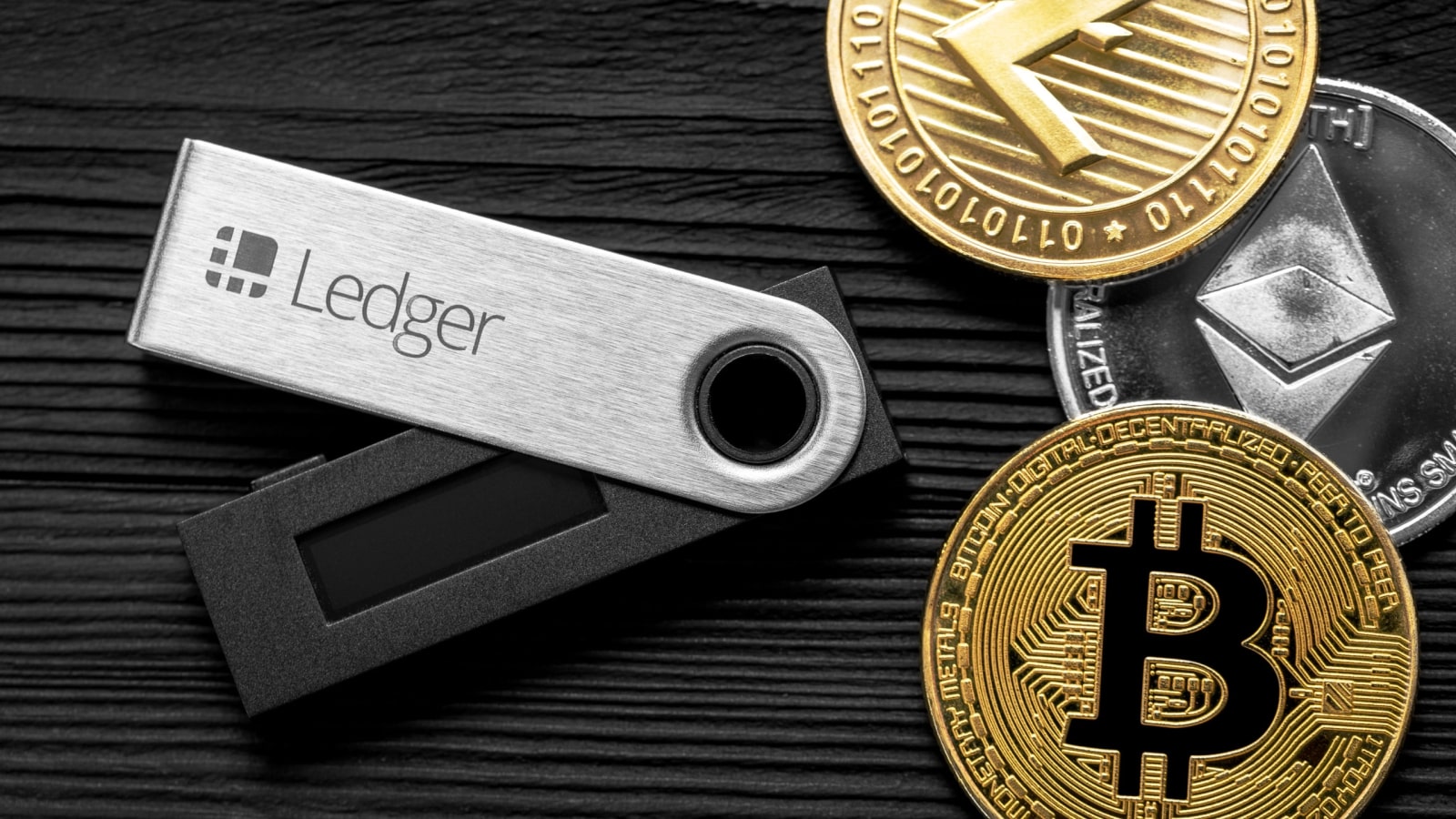Every year, billions of dollars’ worth of cryptocurrency are lost to hacks, scams, and user error. As digital assets become more valuable, they also become a bigger target for online criminals and sophisticated scams. Protecting your crypto holdings is no longer optional; it’s essential.
One of the most secure ways to safeguard your digital wealth is by using hardware wallets, also known as cold wallets. These offline devices keep your private keys away from the internet, dramatically reducing the risk of hacks and theft.
Whether you’re new to crypto or a seasoned investor, staying educated on best practices for managing your digital assets is your first line of defence.
In this guide, we’ll explain what cold wallets are, why they’re so important, and which devices stand out as the best cold wallets for crypto in 2025. By the end, you’ll know how to protect your private keys, defend against online threats, and keep your crypto safe for the long term.
What Is a Cold Wallet and How Does It Work?
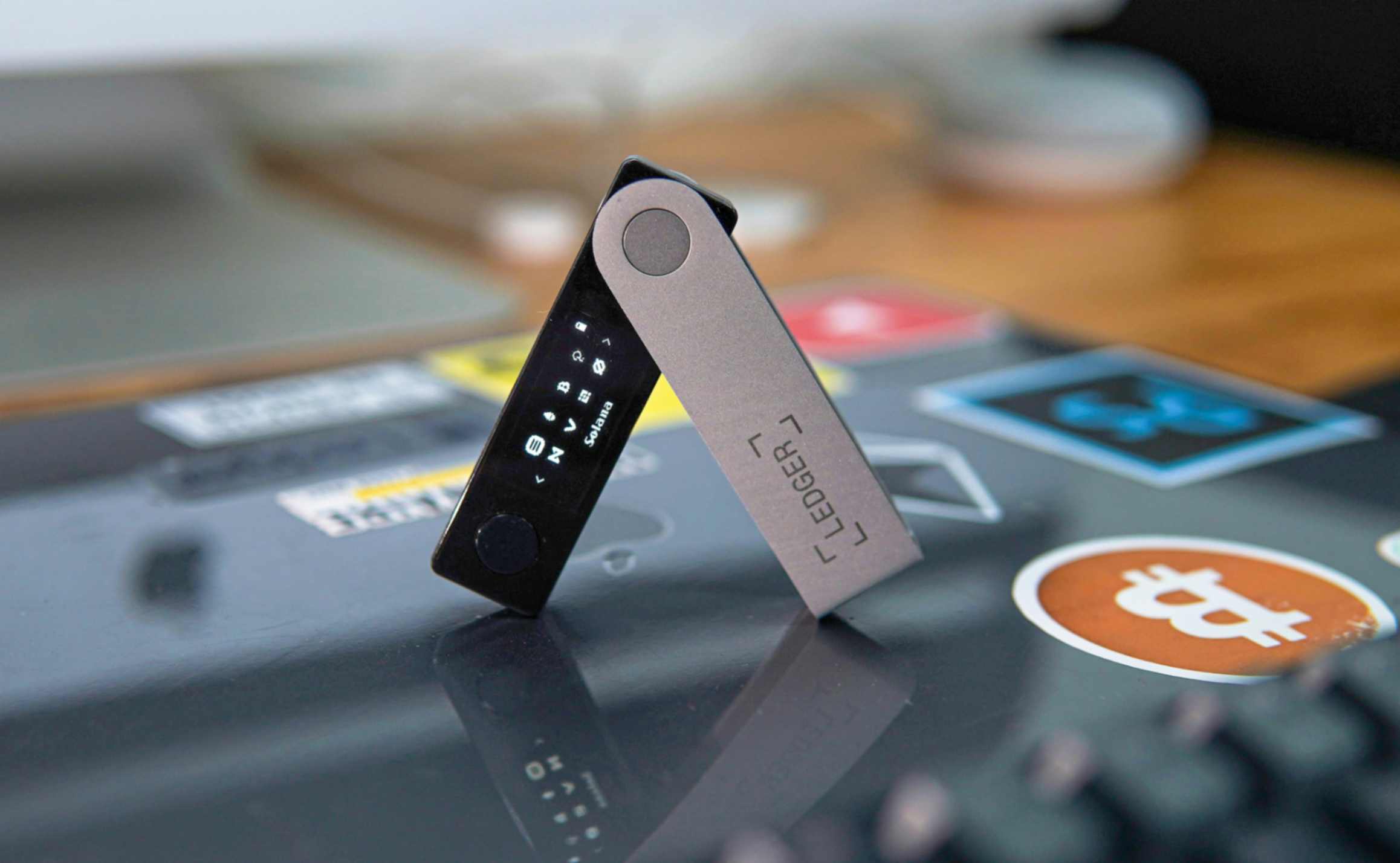
A crypto wallet is a type of hardware wallet that stores your private keys offline, separated from the internet. Unlike hot wallets, which are constantly connected to the internet and thus more susceptible to hacking, cold wallets keep your cryptocurrencies and digital assets out of reach of cybercriminals.
Cold wallets require you to manually sign and approve transactions on the physical device, keeping your assets safe from remote attacks. However, it’s still crucial to carefully review each transaction and verify the legitimacy of all transactions before signing to prevent malicious actions.
Cold Wallets vs Hot Wallets – Key Differences
Unlike hot wallets, cold wallets require physical access to the device. This means only you can approve transactions, adding a layer of enhanced security against unauthorized crypto transactions. Let’s have a look at the key differences between the two:
| Feature | Cold Wallets | Hot Wallets |
| Connection | Not connected to the internet (offline) | Constantly connected (online) |
| Storage Location | Hardware device (physical) | Software/app/browser extension |
| Security Risk | Minimizes online attacks, brute force attacks | Exposed to online threats |
| Convenience | Less convenient for frequent transactions | Ideal for active crypto use |
| Key Control | Private keys offline, self custody | Private keys are stored online |
| Example Devices | Ledger, Trezor, Tangem | Coinbase Wallet, MetaMask, Phantom |
Why Cold Wallets Are Essential for Long-Term Storage
Cold storage is widely recognized as the gold standard for crypto security. The primary benefits include:
- Offline Storage of Private Keys: Most cold wallets store your private keys offline, greatly reducing the risk of hacking, phishing, and malware.
- Self-Custody / Non-Custodial: You retain full control over your private keys and digital assets, with no reliance on 3rd party services. You’re able to recover your assets with your recovery phrase if you lose access to your device.
- Defense Against Online Threats: Hardware wallets are immune to most of the risks faced by devices that are always connected to the internet.
- Multi-Asset Support: You would want to look for a cold wallet that supports tokens that you need across various blockchain networks.
Key Security Features of the Best Cold Wallets

The best cold wallets are designed with advanced, multi-layered security to keep your crypto assets safe. Below are some of the key features that make them highly secure and reliable:
Private Keys Stored Offline
The cornerstone of cold wallet security is the storage of private keys offline. This means that the cryptographic data that proves your ownership of digital assets never touches a device connected to the internet.
This fundamental isolation prevents a wide array of cyberattacks, including remote hacking, malware infections, and brute force attacks that attempt to guess your private keys.
When a transaction needs to be signed, the user needs to manually approve on the hardware wallet offline, ensuring that no bad actors can remotely take over your wallet and make malicious transactions.
Recovery Options and Seed Phrases
Upon initial setup, virtually all reputable hardware wallets generate a recovery phrase, often referred to as a seed phrase. This is typically a sequence of 12, 18, or 24 words. This phrase serves as the master key to recover access to your funds if your physical device is lost, stolen, or damaged. It’s crucial to:
- Write it down: Never store your recovery phrase digitally (e.g., on your computer, phone, or in the cloud).
- Store it securely offline: Keep multiple copies in different, physically secure locations, like in your safe box. Options like metal seed storage can offer superior durability against fire and water.
- Understand the risk: Anyone who gains access to your recovery phrase can gain control of your funds. If you lose access to your seed phrase and your device is compromised or lost, your crypto could be gone forever.
Physical Device Security and Build Quality
Beyond offline storage, the physical integrity of the hardware wallet is paramount:
- Secure Element: Many high-quality hardware wallets, such as those from Ledger and Trezor Safe 5, incorporate a secure element chip. This specialized, tamper-resistant chip is designed to securely generate and store your private keys, making it extremely difficult for attackers to extract them, even with physical access to the device. This is similar to the technology used in passports and credit cards.
- Tamper-Proof Design: Reputable manufacturers design their devices with tamper-evident packaging and internal mechanisms to detect if the device has been physically compromised.
- PIN Protection: Accessing the device typically requires a PIN code, which protects against unauthorized access if the device falls into the wrong hands. Multiple incorrect PIN entries often result in the device wiping itself, requiring recovery via the seed phrase.
- Build Quality: A robust build quality ensures the device can withstand normal wear and tear, reducing the risk of accidental damage.
Best Cold Wallets for Crypto in 2025
A selection of premium hardware wallets combines enhanced security with user-friendly design, making them ideal for long-term crypto storage. Here are some of the best options available:
Ledger Nano X & Ledger Nano S Plus
Ledger is renowned for its secure element chips and wide range of device choices. All Ledger wallets are non-custodial and support thousands of coins and tokens. The latest models include:
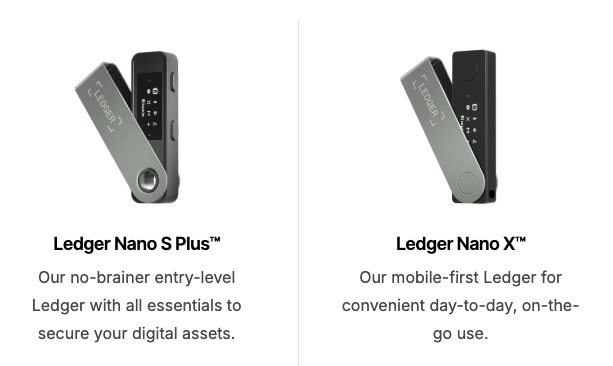
Source: https://shop.ledger.com/
Ledger Nano S Plus: An excellent entry-level choice, the Nano S Plus is an upgrade from the original Nano S, offering more memory for installing applications and a larger screen for easier crypto transactions verification. It connects via USB-C and supports a vast range of coins and tokens. Its lack of Bluetooth connectivity makes it a preferred choice for users who prioritize a purely wired, air-gapped experience during transactions.
- Pros: Affordable, highly secure (Secure Element), wide crypto support, larger screen than original Nano S.
- Cons: Doesn’t support NFTs, unlike the Nano X, potentially making NFT management more cumbersome.
Ledger Nano X: The flagship mobile-first device, the Ledger Nano X features Bluetooth connectivity and a built-in battery, allowing for seamless management of crypto assets on the go via the Ledger Live mobile app. It supports an extensive list of cryptocurrencies and NFTs, and offers ample storage capacity for multiple applications.
- Pros: Bluetooth for mobile use, extensive crypto and NFT support, robust secure element, and larger app storage.
- Cons: More expensive than the entry-level Nano S Plus.
Ledger Stax & Ledger Flex – The Newest Models
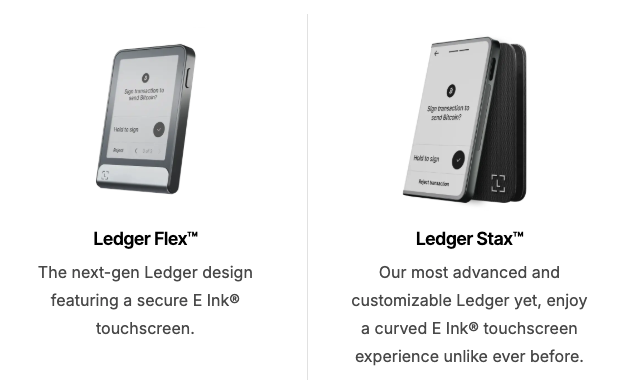
Source: https://shop.ledger.com/
Ledger Stax: Designed by iPod creator Tony Fadell, the Ledger Stax is a premium hardware wallet featuring a large, customizable E Ink touchscreen. Its unique curved display is designed for ease of use, especially for managing NFTs and verifying complex crypto transactions. It supports Bluetooth connectivity, NFC, and wireless Qi charging, offering a highly intuitive and feature-rich experience. The “stackable” magnetic design is also a unique aesthetic touch.
- Pros: Large, customizable E Ink touchscreen, intuitive UI, wireless charging, extensive crypto/NFT support, premium build quality.
- Cons: Significantly more expensive than other Ledger models, making it less accessible for budget-conscious users.
Ledger Flex: The Ledger Flex is Ledger’s latest innovation, featuring an industry-first Secure Element-driven E Ink touchscreen. It combines next-gen security with everyday convenience, designed to handle all your crypto needs on the go. It also offers integration with the Ledger Recover service for an additional layer of recovery options.
- Pros: Secure E Ink touchscreen, both Bluetooth and USB-C connectivity, strong security, good for on-the-go.
- Cons: More expensive than the Ledger Nano S Plus and Nano X, though less so than the Stax.
Trezor Model T and Trezor One
Trezor is another highly respected name in crypto security, known for its open-source philosophy and continuous innovation. Both Trezor wallets are managed through the Trezor Suite application.
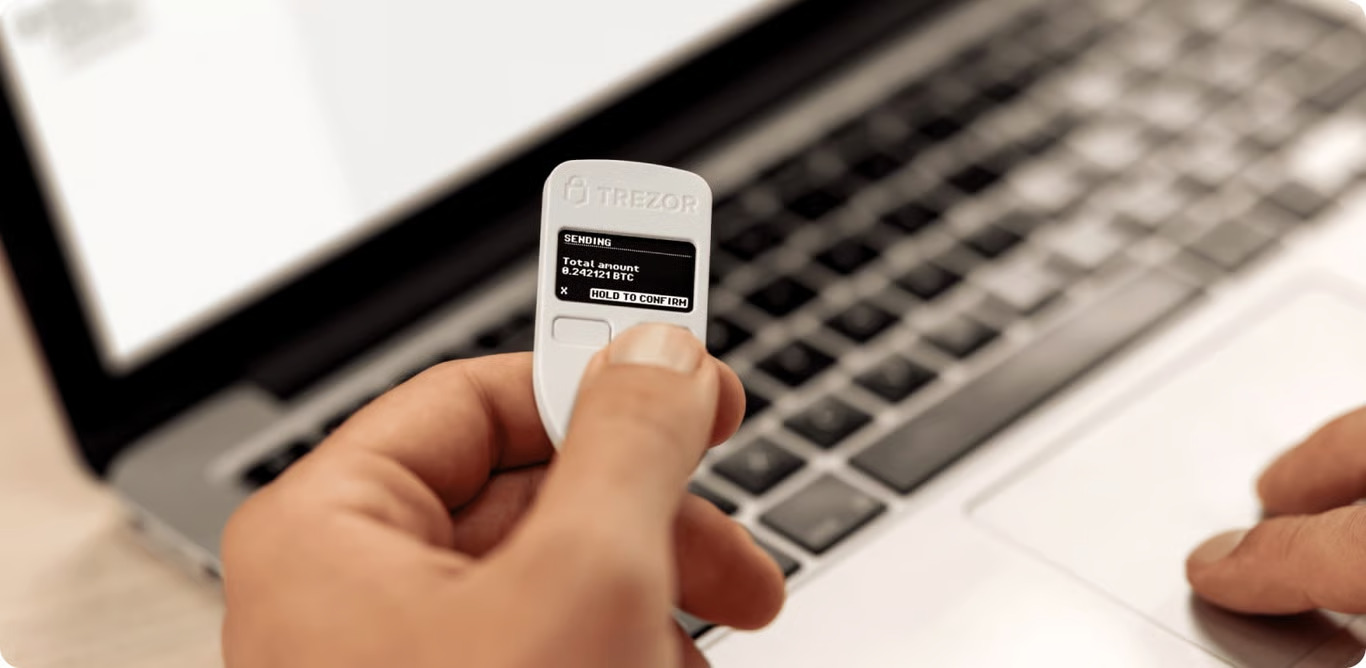
Source: https://trezor.io/trezor-model-one
Trezor Model One: The Trezor Model One is a cost-effective and battle-tested option. It features a monochrome display and two buttons for navigation. While it may feel a bit less modern than newer devices, its security track record is impeccable. It supports a wide range of cryptocurrencies, though some newer or less common coins might be exclusive to the Model T.
- Pros: Affordable, open-source (transparent security), well-established, good crypto support.
- Cons: Lacks native support for some popular cryptocurrencies (like XRP, ADA, SOL) and NFTs.
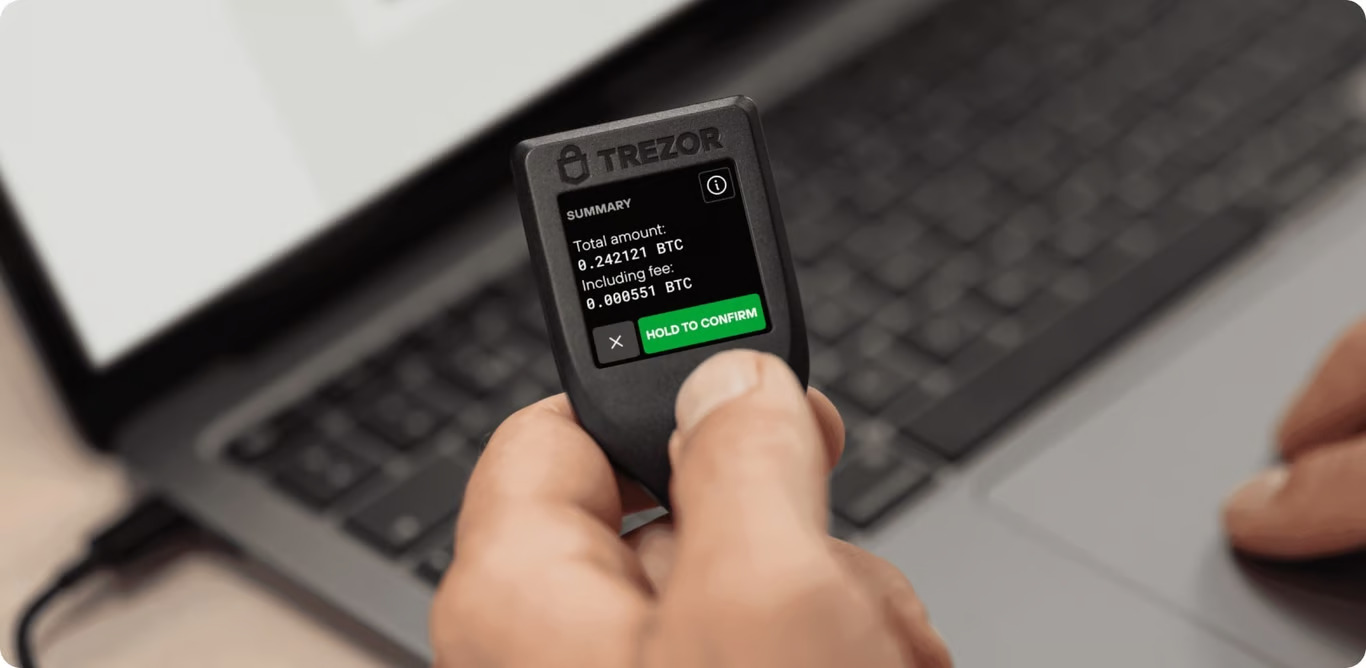
Source: https://trezor.io/trezor-model-t
Trezor Model T: The Trezor Model T is Trezor’s advanced model, boasting a full-color touchscreen that simplifies navigation and crypto transactions verification. It offers broader support for blockchain networks and coins and tokens than the Model One, including advanced recovery options like Shamir Backup, which allows users to split their seed phrases into multiple shares for enhanced protection. Recent updates in 2025 have added support for Solana staking and improved WalletConnect integration for dApps.
- Pros: Color touchscreen, excellent user experience, open-source, advanced recovery features (Shamir Backup), broad crypto support, ongoing feature updates.
- Cons: Does not include a Secure Element chip, a design choice some users prefer for enhanced physical attack resistance.
Tangem Wallet – Simplicity Meets Security
The Tangem Wallet offers a unique approach to cold storage. Instead of a traditional device with a screen and buttons, it’s a credit-card-sized physical device that uses NFC (Near Field Communication) to interact with your smartphone via the Tangem app.
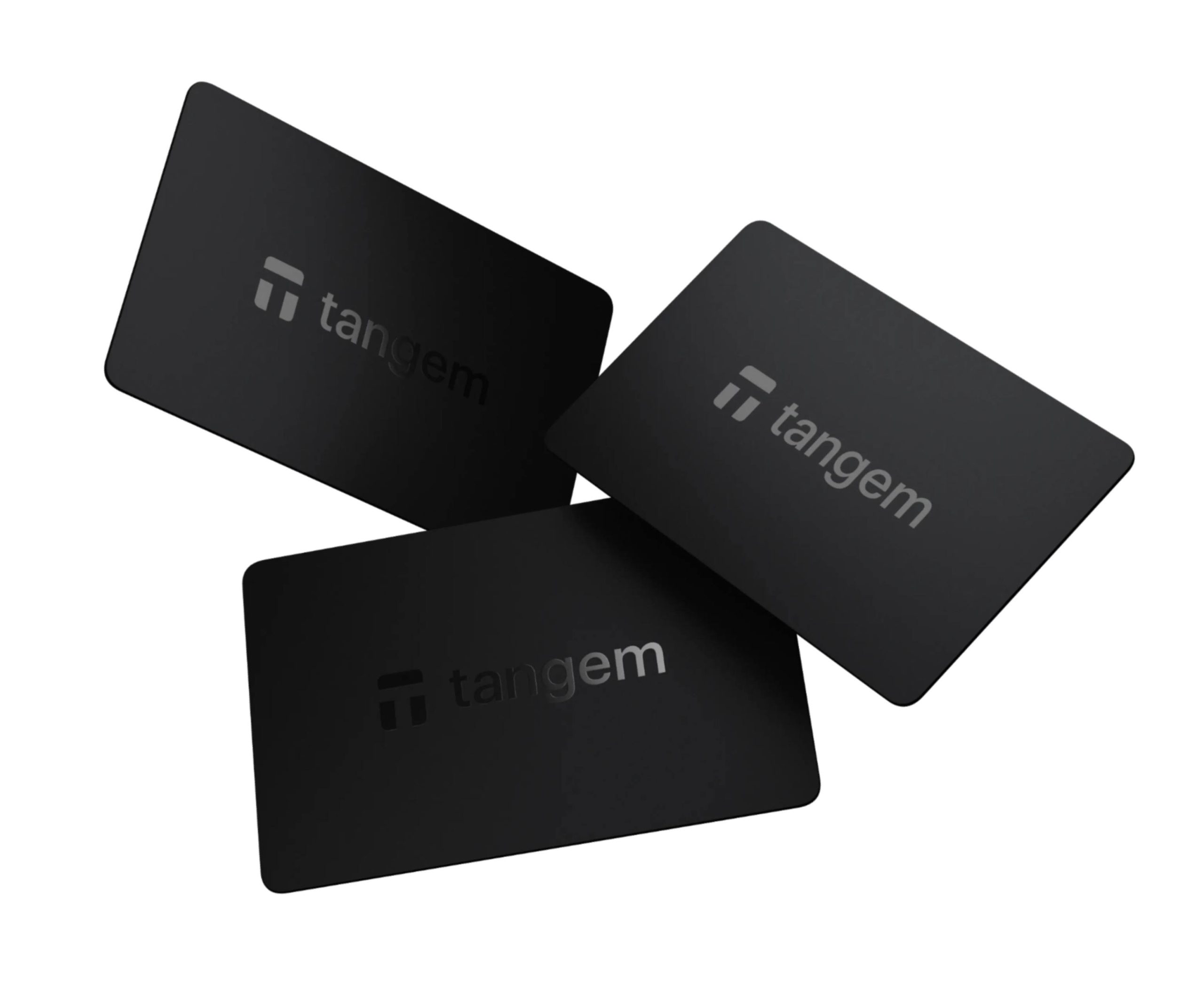
Source: https://tangem.com/
Simplicity: The Tangem Wallet is incredibly simple to set up and use, making it ideal for beginners. There are no cables, batteries, or screens to worry about.
Backup Cards: A Tangem Wallet set typically includes two or three identical cards. These additional cards act as backups, eliminating the need for a recovery phrase in the traditional sense, which can be appealing for some users. However, if you lose all your Tangem cards, you could lose access to your crypto.
Durability: Made with a monolithic design, Tangem cards are highly durable and resistant to water, dust, and extreme temperatures, with an expected lifespan of at least 25 years.
Secure Element: Each Tangem card contains an EAL6+ certified secure element chip where your private keys offline are generated and stored offline, ensuring robust crypto security. As of July 2025, Tangem supports over 16,000 cryptocurrencies across more than 85 blockchain networks, and has added native NFT support and improved WalletConnect integration for dApps.
- Pros: Extremely simple to use, no seed phrase to manage (if using multiple cards), very durable, compact design, broad asset support.
- Cons: Limited integration with DeFi and dApps, meaning advanced features like staking and complex smart contract interactions might be less streamlined or not natively supported.
How to Choose the Right Cold Wallet for Your Crypto Holdings
Selecting the ideal cold wallet involves considering several factors to match your specific needs:
Which Wallet Supports the Most Coins and Tokens?
If you manage a diversified crypto portfolio or plan to hold a wide variety of digital assets, it’s essential to choose a wallet that supports multiple blockchain networks and a broad range of tokens.
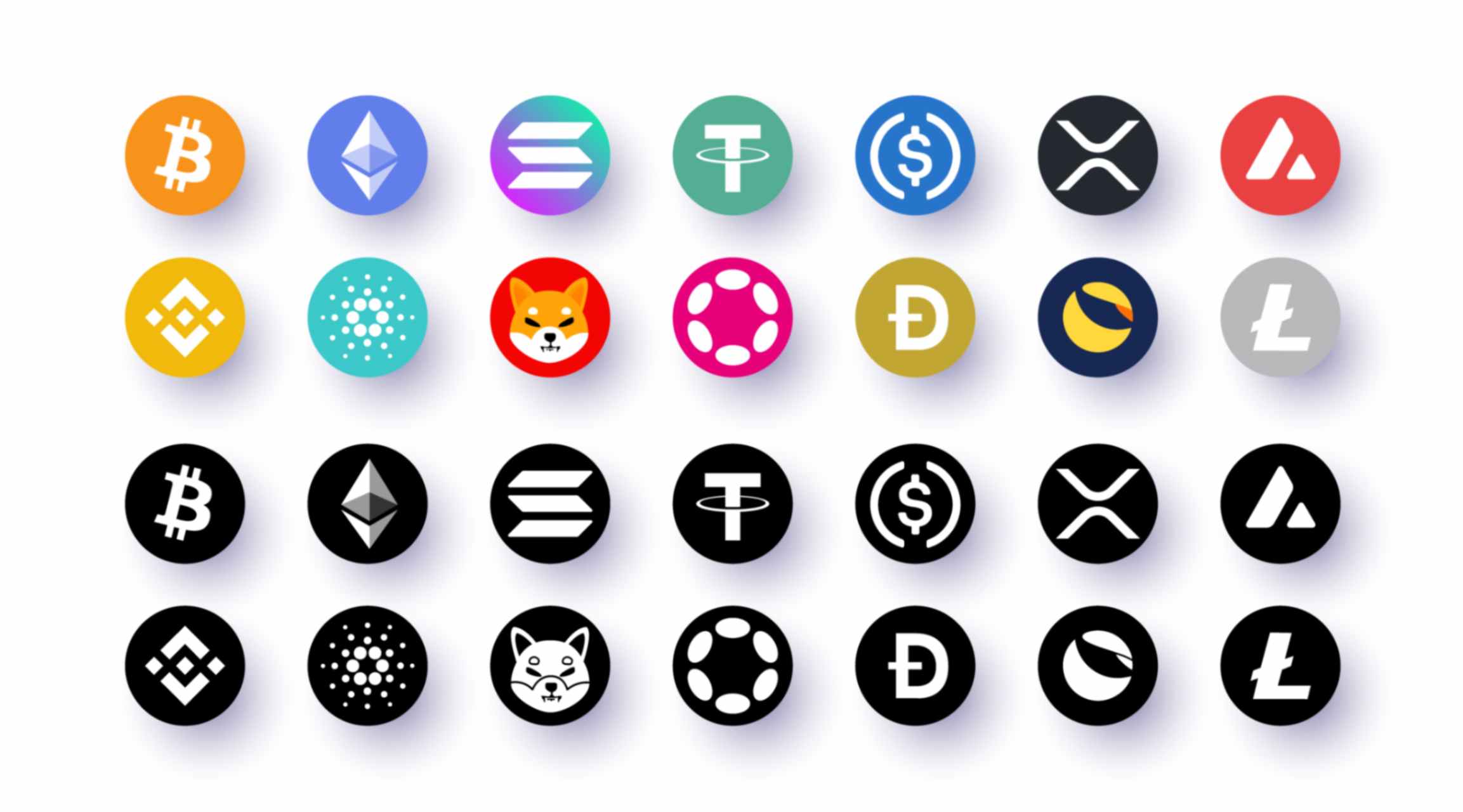
Most cold wallets from leading brands support thousands of assets, but some newer or less common coins might have specific wallet requirements. Always check the manufacturer’s website for the most up-to-date list of supported cryptocurrencies and token standards (e.g., ERC-20, BEP-20, SPL).
Balancing Security vs Convenience
There’s often a trade-off between absolute security and everyday convenience.
- For maximum security and an entirely air-gapped experience, devices that rely solely on USB connections (like the Ledger Nano S Plus or the Trezor Model One) are ideal.
- If you value the convenience of managing your crypto on your smartphone, a wallet with Bluetooth connectivity like the Ledger Nano X or Ledger Stax might be preferable. These devices are still highly secure, as private keys never leave the secure element during Bluetooth communication, but some users prefer to eliminate any wireless vectors.
- The Tangem wallet offers a unique balance, combining high security with extreme ease of use through its NFC integration.
Consider your personal use habits: will you be making frequent small transactions, or are you primarily focused on long-term storage with infrequent access?
Self-Custody vs Third-Party Services
A fundamental decision in crypto is whether to maintain self-custody of your funds or rely on third-party providers (like exchanges).
- Self-Custody: Using a cold wallet means you are entirely responsible for your private keys and recovery phrase. This gives you ultimate control and eliminates counterparty risk, but also places the burden of security squarely on your shoulders. If you lose your seed phrase, you lose access to your funds.
- Third-Party Services: Storing crypto on an exchange like Coinbase means they hold your private keys. This offers convenience and often includes features like easy buying of crypto and crypto transaction services. However, it introduces the risk of hacks, regulatory issues, or internal mismanagement from the company that operates and provides the service.
For significant amounts of crypto, self-custody with a cold wallet is almost universally recommended by security experts.
How to Use and Secure Your Cold Wallet
Once you’ve selected the right cold wallet, properly setting it up and securing it is essential to ensure maximum protection for your digital assets.
Setting Up Your Hardware Wallet
The initial setup typically involves:
- Unboxing and Verification: Carefully inspect the packaging for any signs of tampering. Purchase directly from the official manufacturer’s website to avoid compromised devices.
- Firmware Installation/Update: Follow the instructions to install or update the device’s firmware to the latest version. This ensures you have the most up-to-date security features.
- PIN Creation: Set a strong PIN code (usually 4-8 digits, or longer on some models like Trezor) that you will use to unlock the device. This added security layer prevents unauthorized access.
- Recovery Phrase Generation: Your device will generate a recovery phrase (12, 18, or 24 words). This is the single most important step. Write these words down carefully, in order, on the provided recovery cards. Do not take photos, type them into a computer, or store them online.
- Recovery Phrase Confirmation: The wallet will typically ask you to confirm a few words from your recovery phrase to ensure you’ve written them down correctly. This is a critical check.
- Optional Passphrase: Some wallets offer an optional 25th word or passphrase (e.g., Ledger, Trezor). This acts as a hidden wallet within your main wallet, providing an extra layer of protection against physical compromise, but also an extra layer to remember.
- Software Installation: Install the companion software (e.g., Ledger Live, Trezor Suite, Tangem app) on your computer or smartphone to manage your assets and initiate transactions.
How to Safely Store Your Recovery Phrase
This is the most critical aspect of crypto security with cold wallets. Losing your recovery phrase or having it compromised means permanent loss of your funds.
- Physical, Offline Storage: Store multiple copies of your recovery phrase in physically secure locations. Think fireproof safes, secure deposit boxes, or even buried in different spots.
- Durable Mediums: Consider using metal seed storage solutions (e.g., engraved steel plates) that are resistant to fire, water, and corrosion, offering much better protection than paper.
- Avoid Digital Copies: Repeat: never take a photo, screenshot, or type your seed phrases onto any device connected to the internet.
Regular Updates and Maintenance
Just like any software, hardware wallet firmware requires regular updates. Manufacturers release updates to:
- Fix vulnerabilities & improve performance: Patching any newly discovered security features or flaws to oprimize the device’s operating system.
- Add new features: Enhancing usability or introducing support for new blockchains and tokens.
Always update your device through the official companion application (e.g., Ledger Live, Trezor Suite) and follow the manufacturer’s instructions carefully. This ongoing maintenance is essential to ensure your cold wallet continues to offer the enhanced security it’s designed for. Consider enabling two-factor authentication (2FA) on any associated accounts for added security.

For cryptocurrency users looking to truly embrace the freedom and decentralization that digital assets offer, securing your funds with a cold wallet is an indispensable step.
At Travala, we understand the importance of both security and utility for your crypto, and we ensure a seamless payment experience directly from your preferred secure cold wallet.
With access to over 3 million travel products worldwide, Travala allows you to easily find the perfect hotels, flights, and activities, all on a single platform. We also enable you to book travel with over 100 cryptocurrencies like Bitcoin, Ethereum, Solana, and stablecoins like USDT and USDC.
By allowing you to spend your cryptocurrencies and digital assets securely on flights, hotels, and activities, Travala bridges the gap between robust crypto security and real-world utility, making your journey into the world of decentralized finance as safe as it is exciting.
START YOUR CRYPTO TRAVEL JOURNEY NOW!
[Book Travel] | [Loyalty Program]
Frequently Asked Questions (FAQs)
Q: What is a cold wallet, and how is it different from a hot wallet?
A cold wallet is a cryptocurrency wallet that stores your private keys offline, meaning it’s never connected to the internet. This provides enhanced security against online threats like hacking. In contrast, a hot wallet is constantly connected to the internet (like exchange wallets or mobile apps), offering convenience for frequent transactions but making it more vulnerable to cyberattacks.
Q: Are cold wallets the safest way to store crypto?
Yes, cold wallets are widely considered the safest way to store crypto, especially for long-term storage of significant digital assets. By keeping your private keys offline, you significantly reduce the risk of remote hacks, malware, and other cyberattacks that hot wallets are susceptible to. While no method is 100% foolproof, cold wallets offer maximum security.
Q: What are the best cold wallets for crypto in 2025?
In 2025, the best cold wallets for crypto include top hardware wallets like the Ledger Nano X, Ledger Nano S Plus, Ledger Stax, Trezor Model T, Trezor One, and the unique Tangem Wallet. These options are lauded for their robust security features, build quality, and user experience, offering secure offline storage for your crypto assets.
Q: What happens if I lose my cold wallet? Can I recover my crypto?
Yes, if you lose your cold wallet, you can recover access to your crypto holdings using your recovery phrase (also known as a seed phrase). This sequence of 12 or 24 words is the master key to your funds. As long as you have securely stored your recovery phrase offline and it hasn’t been compromised, you can restore your wallet on a new compatible device.
Q: Which cold wallets support the most coins and tokens?
Leading cold wallets like the Ledger Nano X, Ledger Stax, and Trezor Model T generally offer extensive support for thousands of coins and tokens across numerous blockchain networks. They are designed so that your wallet supports a wide range of cryptocurrencies and NFTs, often expanding their compatibility with firmware updates and integrations through companion apps like Ledger Live and Trezor Suite.
Q: Can a cold wallet still be hacked?
While cold wallets are highly secure, no system is entirely impervious. A cold wallet itself cannot be hacked remotely because it’s offline. However, vulnerabilities can arise from:
- Compromised Recovery Phrase: If your recovery phrase is discovered or improperly stored, an attacker can lose access to your funds.
- Supply Chain Attacks: Purchasing from unofficial sources could lead to a tampered device. Always buy directly from the manufacturer.
- User Error: Falling for phishing scams that trick you into revealing your PIN or signing malicious transactions can compromise your funds.
Q: Do cold wallets work with DeFi apps and decentralised exchanges?
Yes, cold wallets do work with DeFi apps and decentralized exchanges (DEXs), often through secure connections with browser extensions like MetaMask (using features like WalletConnect). When you interact with a DeFi app or DEX, your private keys remain offline on your hardware wallet, and you approve transactions directly on the physical device, providing enhanced security for your crypto transactions within the decentralized ecosystem.
Q: Are Bluetooth cold wallets like Ledger Nano X secure?.
Yes, Bluetooth cold wallets like the Ledger Nano X are designed to be highly secure. The Bluetooth connectivity is used for communication with your smartphone, but your private keys never leave the secure element chip within the device. All critical operations, such as signing transactions, occur securely on the device itself, making it resistant to wireless hacking attempts.
Q: How much do cold wallets cost, and are they worth the investment?
Cold wallets typically range from $50 to $200, depending on features and models (e.g., Trezor Model One is more affordable than Ledger Stax). They are worth the investment for anyone holding a substantial amount of crypto assets or planning for long-term storage. The relatively small one-time cost offers immense peace of mind and protection against potential losses that could be far greater.
Q: What’s the best way to store a recovery phrase securely?
The best way to store a recovery phrase securely is to write it down physically on paper (or ideally, engrave it onto a durable medium like metal) and keep multiple copies in separate, offline storage locations. Never store it digitally (e.g., on a computer, phone, or cloud service). Ensure these locations are private, fireproof, and waterproof to prevent physical damage or theft, safeguarding your ability to recover access to your digital assets.


